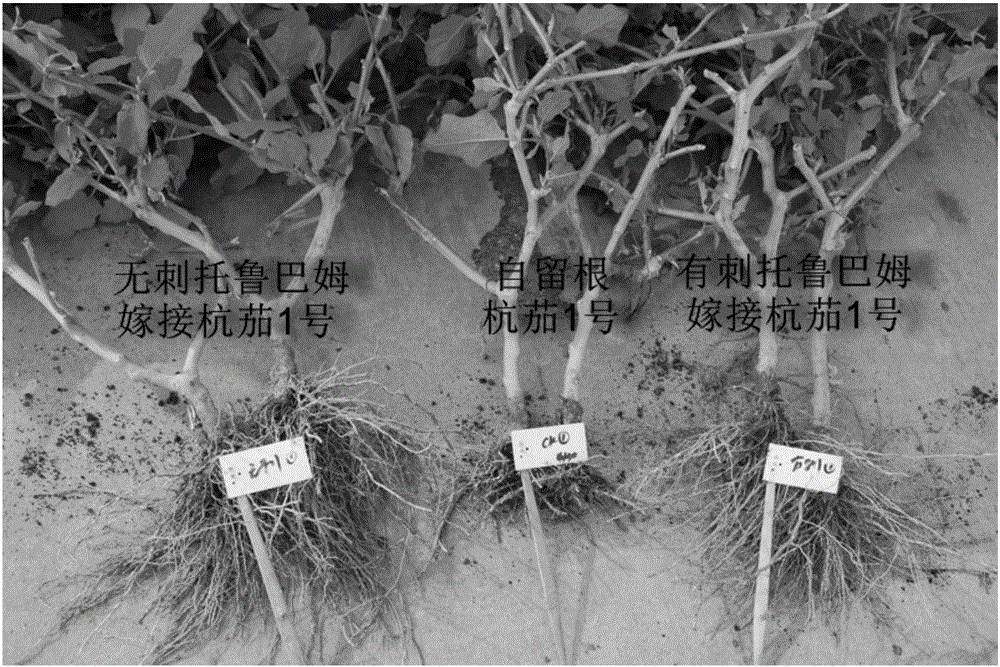High-efficiency cultivation method of grafted Hangzhou eggplant in mountainous region
A cultivation method and technology of Hang eggplant are applied in the field of high-efficiency cultivation in mountainous areas where Hang eggplant is grafted, which can solve the problems of unsound root system development of eggplant plants, weakened plant growth potential, affecting eggplant quality, etc., and achieves high yield, growth potential and early stage. Yield improvement, the effect of increased crude protein content
- Summary
- Abstract
- Description
- Claims
- Application Information
AI Technical Summary
Problems solved by technology
Method used
Image
Examples
Embodiment 1
[0059] The implementation process is as follows:
[0060] (1) Variety selection: 'Hangjia No. 1' with early maturity, high yield and good quality was selected for the scion. The rootstock is torubamu with a well-developed root system, resistance to soil-borne diseases, and good quality.
[0061] (2) Seedling cultivation:
[0062] ① Seed treatment:
[0063] Rootstocks are soaked in late November or early December to accelerate germination, and scions are soaked in mid-to-late December to accelerate germination. First dry the seeds in the sun for 1-2 hours. Fully dissolve 1g of crystalline powder containing 75% gibberellic acid with 75% alcohol, then add water to make the concentration of the soaking solution reach 1600mg / kg, soak the seeds in the solution for 48 hours, wash the seeds with clean water, and then soak them at 30 Germinate under constant temperature conditions, observe the seed moisture, if it is too dry, you can spray water appropriately. About 7 days after t...
Embodiment 2
[0092] Change the seed soaking liquid concentration, other with embodiment 1.
[0093] In this embodiment, the seed soaking and accelerating germination method is as follows: the seed soaking liquid adopts 1550, 1650 and 1750 mg / kg gibberellic acid aqueous solution respectively, first sundry the seeds in the sun for 1 to 2 hours, then soak the seeds in the gibberellic acid aqueous solution for 48 hours, Wash the seeds with clean water, and then germinate at a constant temperature of 30°C±1°C until the seeds are white.
[0094] The effects of different concentrations of soaking solution on the germination of rootstock 'Torubam' are shown in Table 4.
[0095] Table 4
[0096] Concentration of soaking solution (mg / kg)
Germination potential (10d)
Seed dew white (d)
1550
72.5
7
1650
71.8
7
1750
72.2
7
[0097]From the results in Table 4, it can be seen that the concentration of the seed soaking solution can basi...
Embodiment 3
[0100] Seed soaking time when changing seed soaking and accelerating germination, other is with embodiment 1, and different soaking time is as shown in table 5 to the influence of rootstock ' Tuolubam ' germination.
[0101] table 5
[0102]
[0103]
[0104] As can be seen from the results in Table 5, the soaking time can basically reach the results of Example 1 within the range of 38 to 60 hours.
[0105] The cultivation method of this embodiment is basically equivalent to embodiment 1 for the growth vigor, early stage yield and fruit quality of 'Hangqi No. 1'.
PUM
 Login to View More
Login to View More Abstract
Description
Claims
Application Information
 Login to View More
Login to View More - R&D
- Intellectual Property
- Life Sciences
- Materials
- Tech Scout
- Unparalleled Data Quality
- Higher Quality Content
- 60% Fewer Hallucinations
Browse by: Latest US Patents, China's latest patents, Technical Efficacy Thesaurus, Application Domain, Technology Topic, Popular Technical Reports.
© 2025 PatSnap. All rights reserved.Legal|Privacy policy|Modern Slavery Act Transparency Statement|Sitemap|About US| Contact US: help@patsnap.com



